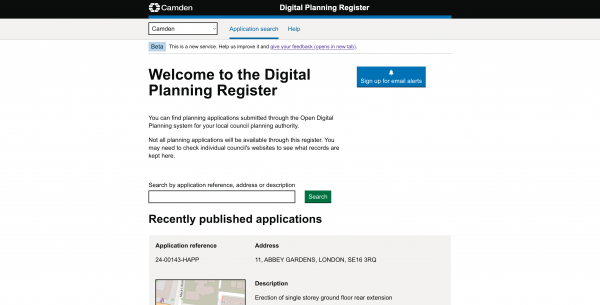Video Guide
Applications and decisions are on the Digital Planning Register for public access and comments.
Why this tool is important
Local planning authorities have a duty to publish all applications that have been validated, which means putting them on a public-facing register. All online registers are designed to fulfil this basic requirement, but the Digital Planning Register aims to go further than what is legally mandated.
The current approach to public consultations often fails to engage a broad spectrum of the community. This leads to feedback that lacks diversity. Local Planning Authorities primarily rely on physical site notices to advertise planning applications, but these can be easily overlooked and offer limited details, hindering public engagement. Online registers can help make this information more accessible. The Digital Planning Register seeks to not only expose information, but to also explain what it is for and guide users to the information most important to them.
Residents often feel uncertain about how their input can influence neighbourhood development. Without clear guidelines, residents tend to provide feedback that is more critical than constructive – focusing on aspects that planners may find challenging to incorporate, or that is outside their scope. The Digital Planning Register presents information in an easy and accessible way, allowing people to comment effectively. It provides guidance on what kind of things planners can take into consideration, and how to effectively have their concerns addressed.
By making the information about applications as accessible as possible, and ensuring the commenting process is as streamlined as it can be, the Digital Planning Register encourages a wider range of people to provide their feedback. In combination with continued improvements on how decisions are communicated, this will help build trust in communities who feel their input is undervalued or ignored.

One simple system that meets all your residents needs
The Digital Planning Register presents planning applications in plain English, including imagery and key metrics for significant applications. The comment submission journey has been tailored to ensure more residents, from all walks of life, can give their opinions on new developments. Everything is designed and built in collaboration with planning authorities and members of the public, to ensure our platform will make it easy for residents to:
- Discover planning applications with multiple, easy-to-use search methods.
- Understand proposals with at-a-glance information on site characteristics, intended use, and potential impact.
- Understand the planning process and how they can get involved with it.
- Voice their opinions and comment on all relevant matters quickly and easily.
- Understand how their feedback is used, including guidance to help them write impactful comments.
- View their comments online and what else is being said by other members of the public.
- Communicate their feedback to developers, who can see the comments online.
- Dive deeper into the details with the application documents, for those interested in learning more.
- Learn how key information about applications is formulated with clear explanations of estimations and calculations.
- Stay updated on any application’s progress through the planning stages.
- Sign up for alerts for new applications relevant to them.
- Easily identify applications that may have a significant impact from their site notices.
- Build trust in their local council planners, by easily seeing the ways their comments have impacted decisions.
How it works for Local Planning Authorities
The Digital Planning Register aims to improve the lives of planning officers and others in the council who support them.
- Continuous, automatic updates: Any changes or progress to the planning application are automatically displayed on the Digital Planning Register, keeping residents informed and up-to-date throughout the planning process.
- Improved public engagement: Residents are encouraged to comment on applications, but guided in the feedback they give, to increase engagement whilst also increasing the quality of that engagement.
- Improved feedback: Feedback from residents is structured on a separate, topic-by-topic basis, and then sent to your back office system where you’ll be able to access it for review. This feedback can be directly used in planning assessments to reflect community input.
- Published decisions: Finalised decisions are made available immediately, to inform the community.
- Reduced upkeep: There’s nothing for the council to manage, no software updates or server maintenance to run. It’s all handled by the Open Digital Planning team and run on its own domain.
- Easy onboarding: The Digital Planning Register has a simple onboarding process for councils whose data is available using the Open Digital Planning schema. We collect a few key pieces of information like links to your related services, and the API (Application Programming Interface) details for your data, and then you’re good to go!
- Enhanced important applications: With Digital Site Notices, applications that anticipate higher engagement can be enhanced to display summaries of information that are important to the public. You can see the types of additional information that planners can publish on Camden’s Digital Site Notice, which was the prototype for this work.
Partnership and roadmap
The direction and delivery of the Digital Planning Register engagement tool is led by a partnership between Camden, Gateshead and Lambeth councils, supported by a TPXimpact development team. Looking forward, our goals for the next two years include taking the Digital Planning Register through an Open Beta (testing) phase to:
- Improve the user experience for residents and planners through iterative user research and testing.
- Extend avenues for public engagement, including proactive approaches like email alerting.
- Improve integration with Back Office Planning System (BOPS) and other digital planning products.
- Support centralising legacy data from other registers such as Uniform, which currently need to be maintained separately.
- Include support for historical data, including digitised paper and microfiche records.
- Increase the richness of data the Digital Planning Register displays, such as integrating 3D models.
Get in touch
Talk to the Digital Planning Register team to discover how your local authority can get started.
